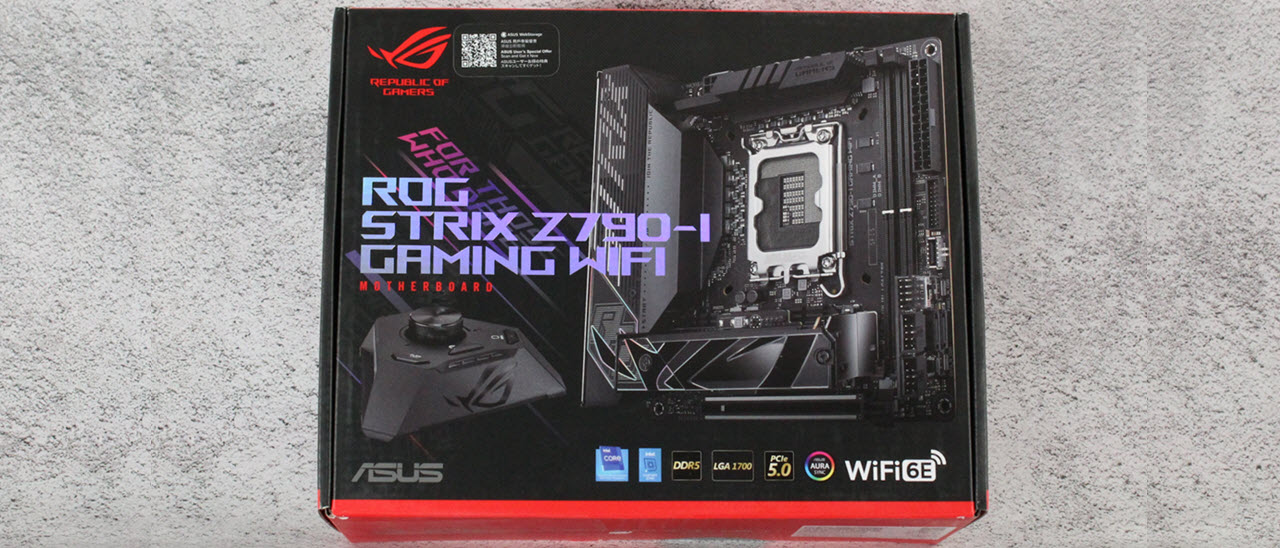Tom's Hardware Verdict
Priced at over $440, the Asus ROG Strix Z790-I Gaming Wi-Fi is a worthwhile but expensive option in the Mini-ITX space. You get the only option with PCIe 5.0-capable M.2 and Thunderbolt 4, a high-quality audio solution, the unique Hive peripheral, and a premium appearance. But four total internal storage options could be limiting, even for small form factor users.
Pros
- +
Dual Thunderbolt 4 (40 Gbps) Type-C ports
- +
Innovative stacked design increases functionality
- +
Cool Hive peripheral
- +
Robust (for Mini-ITX) power delivery
Cons
- -
The priciest Z790 Mini-ITX motherboard
- -
Just two M.2 and two SATA ports
Why you can trust Tom's Hardware
Asus’ ROG Strix Z790-I Gaming Wi-Fi is a high-end Mini-ITX motherboard that positions itself as one of the most handsomely equipped tiny motherboards we’ve seen in a while. Priced at $442.99 on Newegg, you get a PCIe 5.0-capable slot and M.2 socket, dual Thunderbolt 4 (40 Gbps) Type-C ports, a premium audio codec, Asus’ ROG-class Ai features (Ai OC/Cooling/Networking), and some cool Small Form Factor (SFF) innovations like the included ROG Strix Hive and ROG FPS-II card. The black design with “subtle grid-like textures..” and a prism-like effect shining off the embossed ROG logo ooze premium vibes and will blend in with most build themes.
Asus has two Mini-ITX SKUs this generation. The other, ROG Strix B760I Wi-Fi, hails from the B760 chipset and is priced much lower ($199.99) on Asus’ website. If you don’t want or need high-end features like Thunderbolt 4 or PCIe 5.0 M.2, and do not plan to overclock your processor, the B760 version is a more affordable and solid option in the SFF space.
The results of our benchmark testing showed that, out of the box, without implementing any of the AI overclocking features, this is a well-performing board overall. We saw above-average results in some tests and slightly below-average in others. Gaming performance was solid as well. In short, it will be difficult to discern this board’s performance from most others – as it should be.
Below, we’ll dig into the details of the board and see whether it deserves a spot on our Best Motherboards list. Before we get into our testing and board specifics, though, we’ll start by listing the specifications from the Asus website.
Specifications: Asus ROG Strix Z790-I Gaming Wi-Fi
| Socket | LGA1700 |
| Chipset | Z790 |
| Form Factor | Mini-ITX |
| Voltage Regulator | 11-Phase (10x 105A SPS MOSFETs for Vcore) |
| Video Ports | (1) HDMI (v2.1) (2) Thunderbolt 4 |
| USB Ports | (2) Thunderbolt 4, Type-C (40 Gbps) (1) USB 3.2 Gen 2, Type-C (10 Gbps) (3) USB 3.2 Gen 2 (10 Gbps) (1) USB 3.2 Gen 1 (5 Gbps) (2) USB 2.0 (480 Mbps) |
| Network Jacks | (1) 2.5 GbE |
| Audio Jacks | (2) Analog (on ROG Strix Hive) (1) USB Type-C |
| Legacy Ports/Jacks | ✗ |
| Other Ports/Jack | ✗ |
| PCIe x16 | (1) v5.0 (x16) |
| PCIe x8 | ✗ |
| PCIe x4 | ✗ |
| PCIe x1 | ✗ |
| CrossFire/SLI | ✗ |
| DIMM Slots | (2) DDR5 7600+(OC), 96GB Capacity |
| M.2 Sockets | (1) PCIe 5.0 x4 (128 Gbps) / PCIe (up to 80mm) (1) PCIe 4.0 x4 (64 Gbps) / PCIe (up to 80mm) Supports RAID 0/1 |
| SATA Ports | (2) SATA3 6 Gbps (from ROG FPS-II card) Supports RAID0/1 |
| USB Headers | (1) USB v3.2 Gen 1, Type-C (5 Gbps) (1) USB v3.2 Gen 1 (5 Gbps) From the Hive: (1) USB v3.2 Gen 1, Type-C (5 Gbps) (1) USB v2.0 (480 Mbps) From the FPS-II: (2) USB v2.0 (480 Mbps) |
| Fan/Pump Headers | (3) 4-Pin (CPU, CPU/Water Pump, Chassis) |
| RGB Headers | (1) 3-pin ARGB (1) 4-pin RGB |
| Diagnostics Panel | ✗ |
| Internal Button/Switch | ✗ |
| SATA Controllers | ✗ |
| Ethernet Controller(s) | (1) Intel i-226v (2.5 GbE) |
| Wi-Fi / Bluetooth | Intel AX211 Wi-Fi 6E (BT 5.3, 160 MHz, etc.) |
| USB Controllers | Asmedia ASM1442X |
| HD Audio Codec | Realtek ALC4050 w/ESS Sabre9260Q DAC |
| DDL/DTS | ✗ / DTS: Sound Unbound |
| Warranty | 3 Years |
Inside the Box of the Asus ROG Strix Z790-I Gaming Wi-Fi
Inside the retail packaging, below the motherboard, Asus has several accessories sitting neatly in their own section. You get the Asus Hive and the FPS-II units (more on those shortly), along with more typical stuff like SATA cables, a Wi-Fi antenna, screws for M.2 sockets, and more. Below is a list of the included accessories from the Asus website.
- (2)SATA 6Gb/s cables
- ROG USB2.0 splitter cable
- Panel Cable
- ROG FPS-II Card
- ROG STRIX HIVE
- USB Type-C® power connection cable
- Thermal pad for M.2
- ASUS Wi-Fi moving antennas
- Cable ties pack
- Rubber Package(s) for M.2
- Q-Latch package(s) for M.2
- ROG key chain
- ROG Strix stickers
- ROG Strix thank you card
- User guide
The FPS-II is a small PCB that connects to two vertical USB-C ports on the motherboard, providing easy access to the front-panel connectors, a pair of SATA ports, and two USB 2.0 headers, as well as a Clear CMOS header and a CPU_OV jumper for overclocking. Having these features on a removable card is especially handy in SFF builds, as it lets you plug several devices into a card and then plug that into the board, rather than trying to reach into a cramped space and trying to plug in tiny pins or mess with jumpers in a hard-to-reach space.
The Strix Hive, on the other hand, houses the audio hardware and also functions as a port extender and volume knob that also provides extra USB ports, optical out, and Q-LED troubleshooting LEDs, keeping you from having to look inside the case on the board itself when your system suddenly doesn’t boot or function properly.
The fact that the board’s codec is housed in the Hive means you’ll have to use it (there are no audio jacks on the board’s rear IO), but the bottom of the device is magnetic. So if your case has steel side panels, you can easily mount it somewhere that’s convenient.
Design of the Z790-I Gaming Wi-Fi
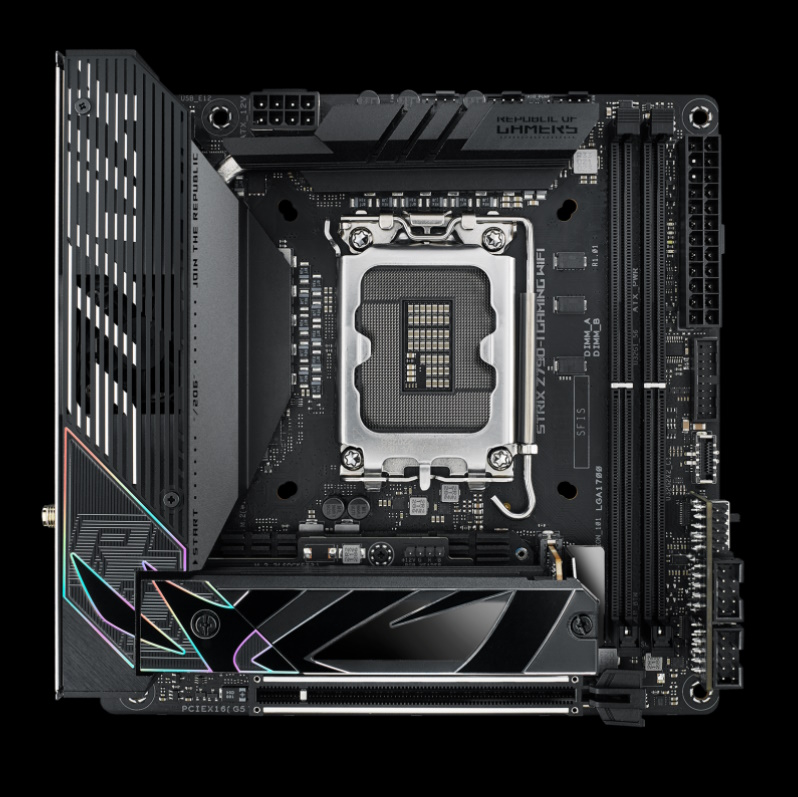
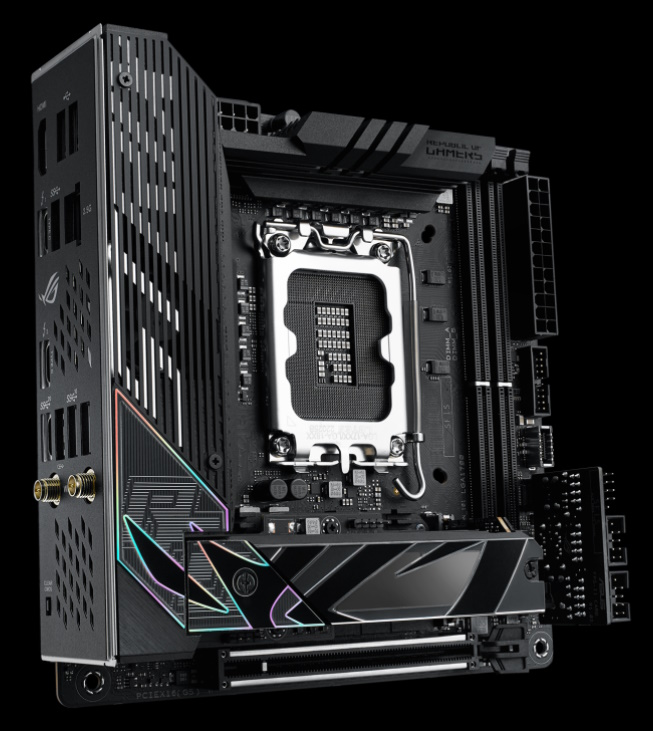
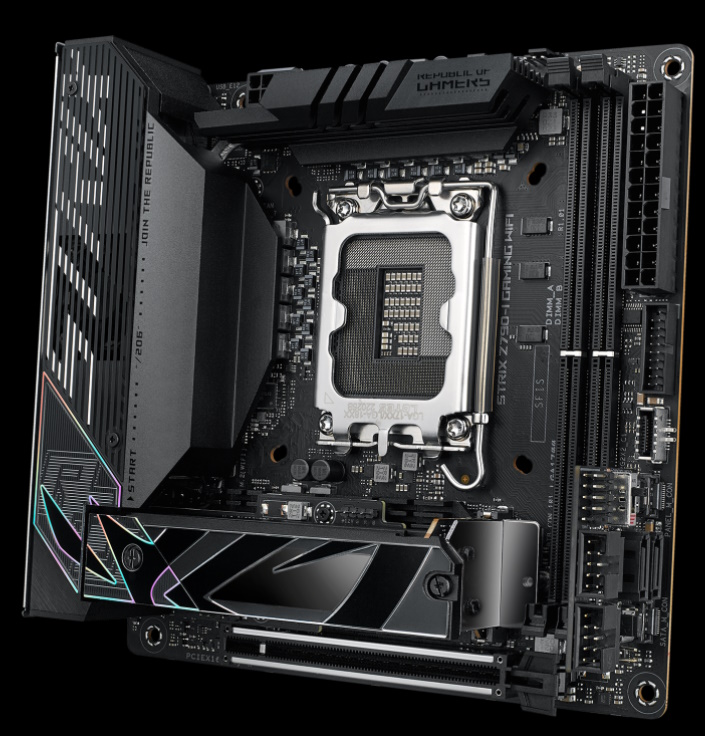
Our diminutive motherboard uses a high-quality, matte-black PCB. The linear vent lines on top of the rear IO cover allow air to circulate through the area and out the top via two small fans hidden below. A large partial ROG symbol with a prism-like sheen graces the unique stacked design that holds both M.2 sockets and the RGB headers with the chipset on the bottom. RGB lovers must add their own via the two onboard headers, as none are integrated. We like the premium vibe and the all-black look will blend into most build themes.
Get Tom's Hardware's best news and in-depth reviews, straight to your inbox.
Starting in the left corner, we can see the 8-pin EPS connector for powering the processor. Below that, the heatpipe-connected and actively cooled VRM heatsink covers the robust power delivery bits. The tiny fans inside stayed quiet during stress testing. I couldn’t hear them over the AIO cooling the CPU.
Across the top edge, above the VRM heatsink, are the three 4-pin fan headers. Each header supports PWM and DC-controlled devices through the BIOS or Armory Crate application. The CPU and Chassis headers are Q-fan controlled by default, while the AIO_PUMP header runs at full speed by default. Three headers should be enough for an SFF system.
Continuing right, we next run into the two reinforced DIMM slots sporting Asus’ Safe DIMM design. As of this writing, support is listed on the website up to 96GB. However, Asus announced in March of 2024 that all Z790 boards had been updated to support 64GB DIMMs, making this board support up to 128GB. The company still needs to update its web pages to reflect this change.
Along the right edge is a slew of functionality. From the top down, we run into the 24-pin EPS connector and front panel USB connectivity, including a 19-pin USB 3.2 Gen 1 (5 Gbps) USB 3.2 Gen 2 (5 Gbps) Type-C and a 19-pin. Below that, you’ll see two Type-C ports sticking up out of the PCB, where you connect the FPS-II board.
Power delivery on the Z790-I Gaming Wi-FI has 11 phases, with 10 dedicated to Vcore. Power travels from the 8-pin EPS connector onto a Renesas RAA229131 PWM controller. From there, it heads to the 10 105A Renesas RAA22010540 SPS MOSFETs. The 1,050A available is plenty to power flagship-class processors like our Intel Core i9-14900K and even overclock them without worry. Your CPU cooling will surely get in the way before the power delivery here.
Continuing our journey at the bottom of the board, we’ll run into the FPS-II add-in board. The tiny PCB adds two SATA ports (where there are none otherwise), two USB 2.0 front panel headers, your front panel header, a PCIe Alternate mode switch, a 2-pin temperature sensor header, and the CPU Overvolt header. It’s a truly unique design that shoehorns features into a limited space. Just behind that is an additional 2-pin temperature sensor and power button headers.
Moving left, we see the only PCIe expansion slot. The full-length slot runs at PCIe 5.0 x16 speeds. It also supports bifurcation to x8/x8 if needed. Above that, under the stacked heatsink tower, are both M.2 sockets and the RGB headers. You get a PCIe 5.0 x4 socket and PCIe 4.0 x4 sockets that handle up to 80mm modules that support RAID0/1 modes (just like the SATA ports).
In this stack, you’ll also find the RGB headers: 3-pin and 4-pin (ARGB and RGB). Control over any of the attached lighting is handled through the Armoury Crate/Aura RGB application. Again, the board is without integrated RGBs, so if you want some lighting, you’ll have to add it to the otherwise stealthy motherboard.
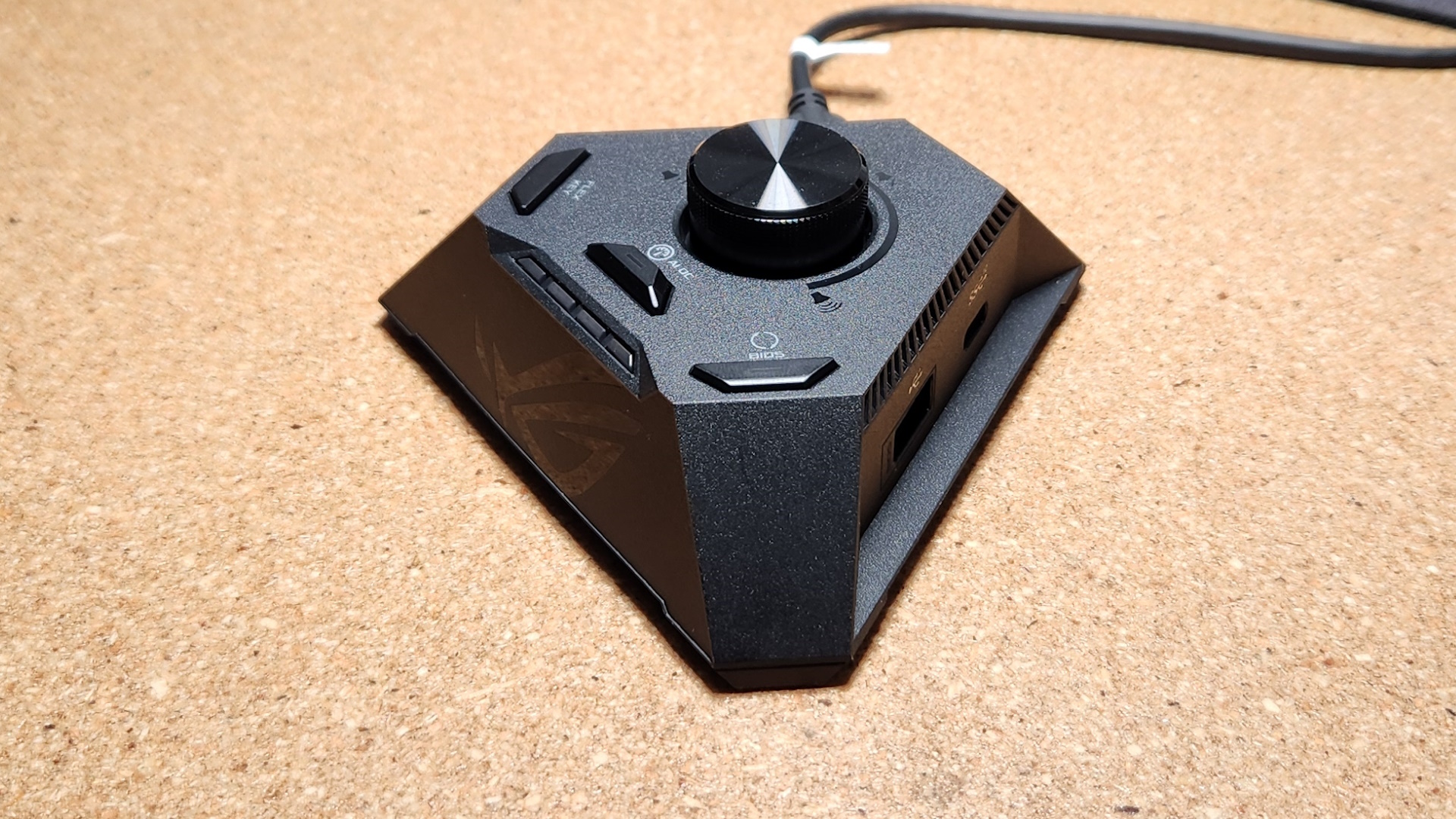
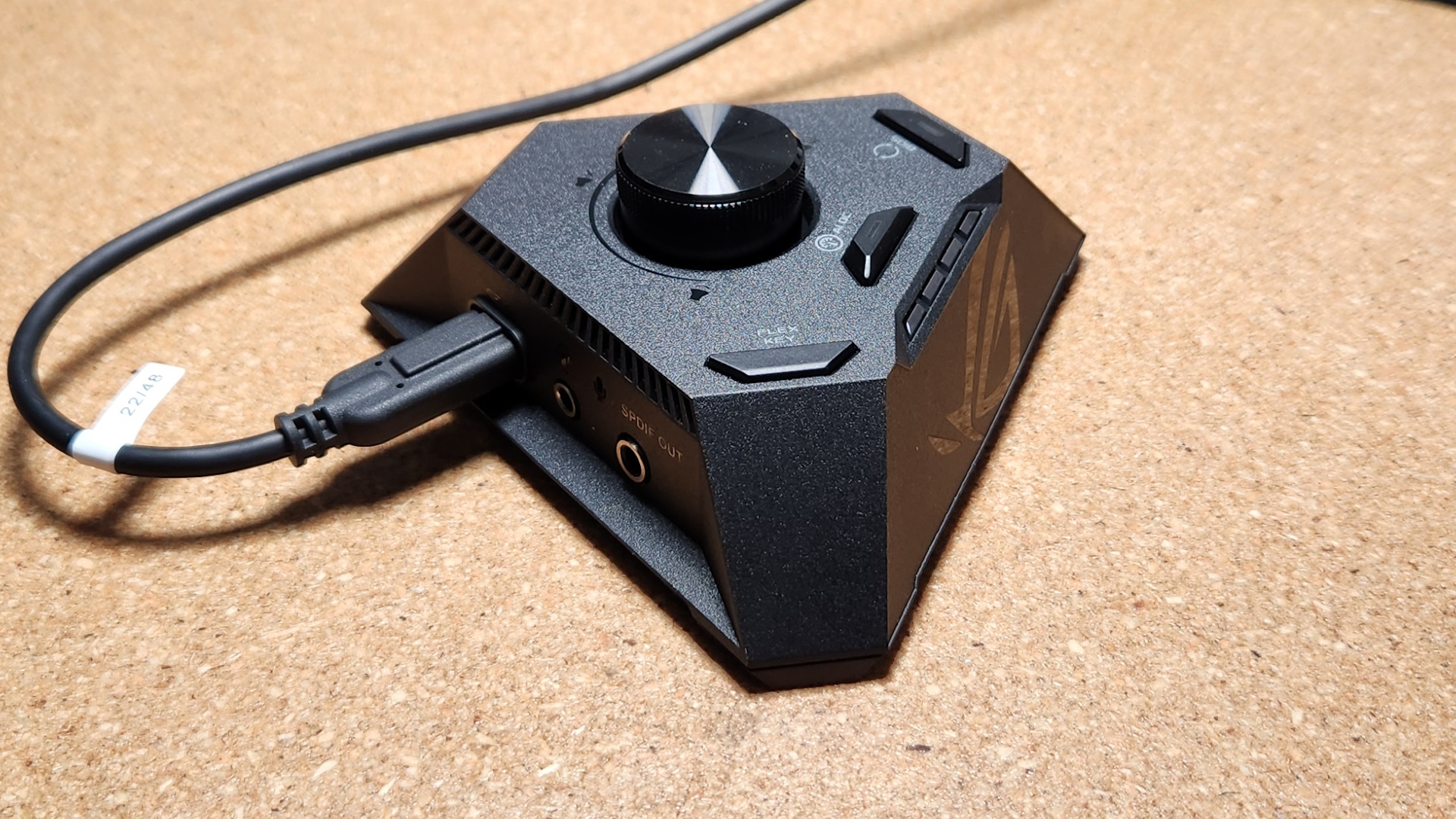
We normally see the audio solution to the left of the PCIe slot. However, Asus has moved it to a triangular-shaped external device called the ROG Strix Hive. Asus says the Hive “brings critical controls and I/O within arms reach...to a compact peripheral that sits on the desktop.” The Hive houses the seldom used, but quality Realtek ALC4050 audio codec and an ESS SABRE9260Q DAC for audio. It also holds additional USB ports (Type-A and Type-C), and, finally, several controls, including the BIOS Flashback button, AI Overclocking button, a Flex key, a large volume knob on top, and the Q-LEDs. The device brings a bit of ATX-type functionality to a Mini-ITX board.
The rear IO plate on the Z790-I Gaming Wi-Fi comes preinstalled on the motherboard, like so many others these days. It sports a black background with white labels on the ports and has several trapezoid-shaped vents to let air into the actively cooled VRM heatsinks. You get six Type-A USB ports (3x 3.2 Gen 2, 1x 3.2 Gen 1, and 2x USB 2.0 ports) and three USB Type-C ports (2x Thunderbolt 4 and 1x 3.2 Gen 2x2). Video output consists of a single HDMI port, while networking is handled by the Intel 2.5 GbE port and the Intel AX211 Wi-Fi 6E. The audio stack is missing in this area, but you’ll find that, along with the two 3.5mm jacks (mic and line out) on the Hive, along with two additional USB ports.
MORE: Best Motherboards
MORE: How To Choose A Motherboard
MORE: All Motherboard Content

Joe Shields is a staff writer at Tom’s Hardware. He reviews motherboards and PC components.
-
scoob010 If it's the same as the AM5 x670e-i the hive takes lanes off one of the usb ports on the FPS-II card. One 2.0 port is labelled with two lanes and the other is labelled AIO as it cannot transfer data. Only RPM and power due to the unusual way it's split to accommodate the hive. Maybe that's obvious to other people but, it had me well and truly stumped for a couple of days. The internet was too busy blaming blown ports to help. Worth mentioning if it's the same.Reply
